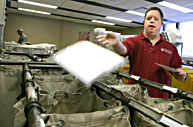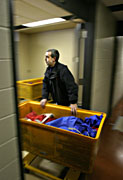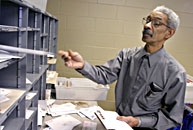Delivering the goods
McGill staff send over one million pieces of mail every year, to everywhere from Borneo to the Burnside Building. And almost every single letter passes through the McGill mailroom, recently relocated to the basement of the McLennan-Redpath Library complex.

Chris Goldik sorts mail bound for McGill's downtown buildings
Owen Egan
Chances are you've seen them, and used them: the red and blue bags hanging in every department at McGill. They're for the mail, of course, but does anyone ever think of what happens to the envelopes once they've disappeared into the sack?
Probably not, and that's a measure of the efficiency with which the mail service at McGill does its job. Complaining about the post is as Canadian as maple syrup, but mail services supervisor Louise Giroux said that her employees are quick and accurate.
"People say it takes two weeks to get through internal mail. Wrong! There's no way it takes two weeks. We pick-up, once a day. If you miss your pick up, for sure, add a day," she said. After pick-up the mail is sorted and put out on the next day's trucks.
Every department at McGill has two bags — one red (for internal) and one blue (for external). Every morning, starting before seven o'clock, two drivers — usually Dino Bisanti and Angelo Cervini — are on the road, travelling from building to building dropping off bags of mail that were sorted the night before, and picking up other bags. These are taken back to the mailroom in the library basement. With these, and the 15 or so containers of mail that comes in from Canada Post, the mailroom sorters begin their day.
Many of those envelopes that are going out into the wide world beyond McGill pass through the hands of Jim Petrie and Jose Nunes.
All mail put into a department's blue bag is billed back to a four-digit code number that corresponds to that department's account. Each piece is weighed to determine the cost of mailing. As each envelope runs through the meter to be stamped, it automatically records the value of the postage, which is then billed back to the department.
International mail operates in a similar way, except that rather than receiving a full postal ink stamp, the envelopes are marked with a line and then transferred to a private company that handles out-of-country post for McGill.
"If you want to put in something helpful for the McGill community, remind them that for international mail they have to write out the country. We know Paris is in France, but to the system, if there isn't the country they can return it," said Petrie. In cases where he catches an error like that, he will often correct it himself, but with hundreds of pieces of mail going through his hands every day, he can't get them all (nor, for that matter, is the mailroom equipped with an atlas).
The volume of mail generated by the university earns us a discount on our mail — a regular envelope going overseas costs only 52 cents, rather than $1.40 for regular post users.
Across the room from Petrie, Bruce Hughes is sorting mail that is bound for the departments.

Dino Bisanti brings the mail from the truck.
Owen Egan
"It's amazing how many people at McGill are just named Joe," he said, reflecting a beef held by many of the mailroom employees: incomplete addresses. "Here's one," he said, showing me an envelope addressed by name only, explaining that when possible he'll send to it to where it's supposed to go.
"But if it's a department that never addresses it properly, I'll just send it back," he said.
Hughes said that in addition to one-name internal mail addresses, he often sees oddly addressed mail come in from outside.
"We got one that was addressed 'McGill University, near The Bay,'" he recalled (that it arrived is a testament to either McGill's name recognition, or The Bay's).
There are seven employees in the main mailroom. The libraries have their own small mailroom, as does Macdonald Campus. The men of the mailroom (with the exception of Giroux, they are all men) laugh and joke as they sort envelopes and sling mailbags about.
Chris Goldik has been with the mailroom for seven years. A valued member of the team, Goldik came to the job from the West Montreal Readaptation Centre. His work involves separating the mail destined for specific buildings, and organizing the bags that are delivered by the drivers to the different departments in the morning. Goldik is not a regular staff member, but Giroux pays for his monthly bus pass out of her budget.
Heather Hanks, an integration agent with the Readaptation Centre, said that the mailroom has proven to be a good environment for Goldik.
"[The workers] keep an eye on each other — they're a close-knit group. He's learned a lot of new things," she said.

Stedman James sails an envelope bound for the James Building into its slot.
Owen Egan
For the most part, mail on main campus goes to the addressed building, and is delivered to each department by that building's porter. The exceptions are smaller building like those along McTavish and Peel, and 688 Sherbrooke, which do not have porters.
Driver Angelo Cervini said the whole system depends on organization and teamwork.
"We have to be one step ahead. When we're here preparing the run, the other two guys are preparing the bags for the next one — it's like a chain," he said.
As might be expected with so many pieces of mail, the occasional memorable article passes through the mailroom.
"We've had times when my staff is a bit scared because we've got things from the hospitals marked hazardous — if the package is leaking, we have a procedure where we bring it to the safety office. For the safety of my staff, if they've touched it in any way, we have to make sure that it's not something that shouldn't have been put in internal mail," said Giroux.
"We used to get live crickets to be delivered to the Redpath Museum. There was mesh so you could see them. They stopped that because the box could be easily damaged and we'd get crickets all over the mailroom."
Personal mail comes through the system as well. As long as the sender has affixed their own postage, that's not a problem, and Giroux will call back to some departments to check questionable mail-outs. She recalls one person who tried to get away with sending 250 wedding invitations on the university's dime.
Other people are a bit more conscientious, if a little misguided.
"When Canada Post raises the price like they did in January, I've seen people tape a penny onto the envelope next to the stamp."
Giroux will open incoming mail that is sent "general delivery" — that is, without a specific person or department — in order to direct it properly. Most often, these are destined for admissions, but sometimes there are less pleasant contents.
"Some are threatening — those are sent to security. We get a few people who are going through their family tree, and see that in 1930 they had an uncle that came to McGill. I send that to archives," she said.
One of the most memorable deliveries Giroux had a hand in was not to a McGill address at all. Giroux had received a call from someone in 688 Sherbrooke who told her that a stray dog was outside the building.
Being an animal lover, Giroux took pity on the beast, which had managed to wander to Sherbrooke all the way from the Old Port, despite being half blind and nearly deaf. Someone had tied the dog up before it did itself any harm.
Giroux got the animal and took a van to take it to the SPCA, paying the $35 boarding charge herself. She never expected to hear more about it.
"This dog was owned by someone in the family of a defenceman with the Montreal Canadiens. It made the front page of the paper — it was summer, so they didn't have a lot of news to report," she said.
Although the sister of the hockey player emailed Giroux to thank her, she never did receive reimbursement for the money she paid to the SPCA from the family. Plus, the news article came to the attention of a higher-up in the university.
"I got in a bit of trouble, because I shouldn't have used the van for that purpose."
With the anthrax scare of two years ago, mailrooms across the country were on edge. That fear came to McGill when a hoax envelope was opened in the Stewart Biology Building. Because it was properly addressed, the envelope went through the mailroom without raising any alarm. Although during the scare the Stewart Building was evacuated, the mailroom wasn't even notified of the problem.
This doesn't faze Giroux.
"Security did tell me that if an envelope is not addressed clearly or if it's stained, to not open it. I said I don't want to get into this paranoia," said Giroux, adding that the mailroom staff know what to do if there is a problem.
Of course the one question that almost everyone has about postal employees — do they read the postcards that pass through their hands? Giroux laughed, and admitted, "If one really catches the eye. We don't really read them — it's more often the picture that gets our attention."
